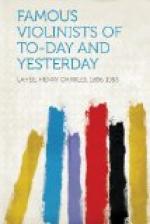John Banister lived in times when fiddle playing was not highly esteemed, if we may judge by the following ordinance, made in 1658: “And be it further enacted by the authority aforesaid, that if any person or persons, commonly called Fiddlers, or minstrels, shall at any time after the said first day of July be taken playing, Fiddling, or making music in any inn, alehouse, or tavern or shall be proffering themselves, or desiring, or entreating any person or persons to hear them play ... shall be adjudged ... rogues, vagabonds, and sturdy beggars.”
John Banister seems to have been a somewhat “sturdy beggar,” though not exactly in the sense meant by the ordinance, for he established regular concerts at his house, “now called the Musick-school, over against the George Tavern in Whitefriars.” These concerts began in 1672, and continued till near his death, which occurred in 1679. He too, was buried in the cloister of Westminster Abbey. His son, also, was an excellent performer on the violin, and played first violin in the Italian opera when it was first introduced into England. He was one of the musicians of Charles II., James II., William and Mary, and of Queen Anne.
Henry Eccles, who lived about the end of the seventeenth century, went to France, where he became a member of the king’s band, and William Corbett, who went to Italy to study the violin in 1710, was a player of much ability; but one of the most eminent of English violinists was Matthew Dubourg, born 1703, who played at a concert when he was so small that he was placed on a stool in order that he might be seen. At eleven years of age he was placed under Geminiani, who had recently established himself in London. Dubourg was appointed, in 1728, Master and Composer of State-Music in Ireland, and on the death of Festing, in 1752, he became leader of the king’s band in London, and held both posts until his death in 1767.
An amusing incident is related of Dubourg and Handel. The latter visited Dublin and presided at a performance of the “Messiah.” A few evenings later, Dubourg, who was leader of the band at the Theatre, had to improvise a “close,” and wandered about in a fit of abstract modulation for so long that he forgot the original key. At last, however, after a protracted shake, he landed safely on the key-note, when Handel called out in a voice loud enough to be heard in the remotest parts of the theatre, “Welcome home, welcome home, Mr. Dubourg.”
Dubourg’s name is the first on record in connection with the performance of a concerto in an English theatre.
John Clegg, a pupil of Dubourg, was a violinist of great ability, whom Handel placed at the head of the opera band, but his faculties became deranged by intense study and practice, and he died at a comparatively early age, in 1742, an inmate of Bedlam.
Another very promising young English violinist was Thomas Linley, who exhibited great musical powers, and performed a concerto in public when eight years old. He was sent to Italy to study under Nardini, and through the mediation of that artist he became acquainted with Mozart, who was about the same age. Linley’s career was prematurely closed, for at the age of twenty-two he was drowned through the capsizing of a pleasure-boat.




